Changes in Arable Land Demand for Food in India and China: A Potential Threat to Food Security
Abstract
:1. Introduction
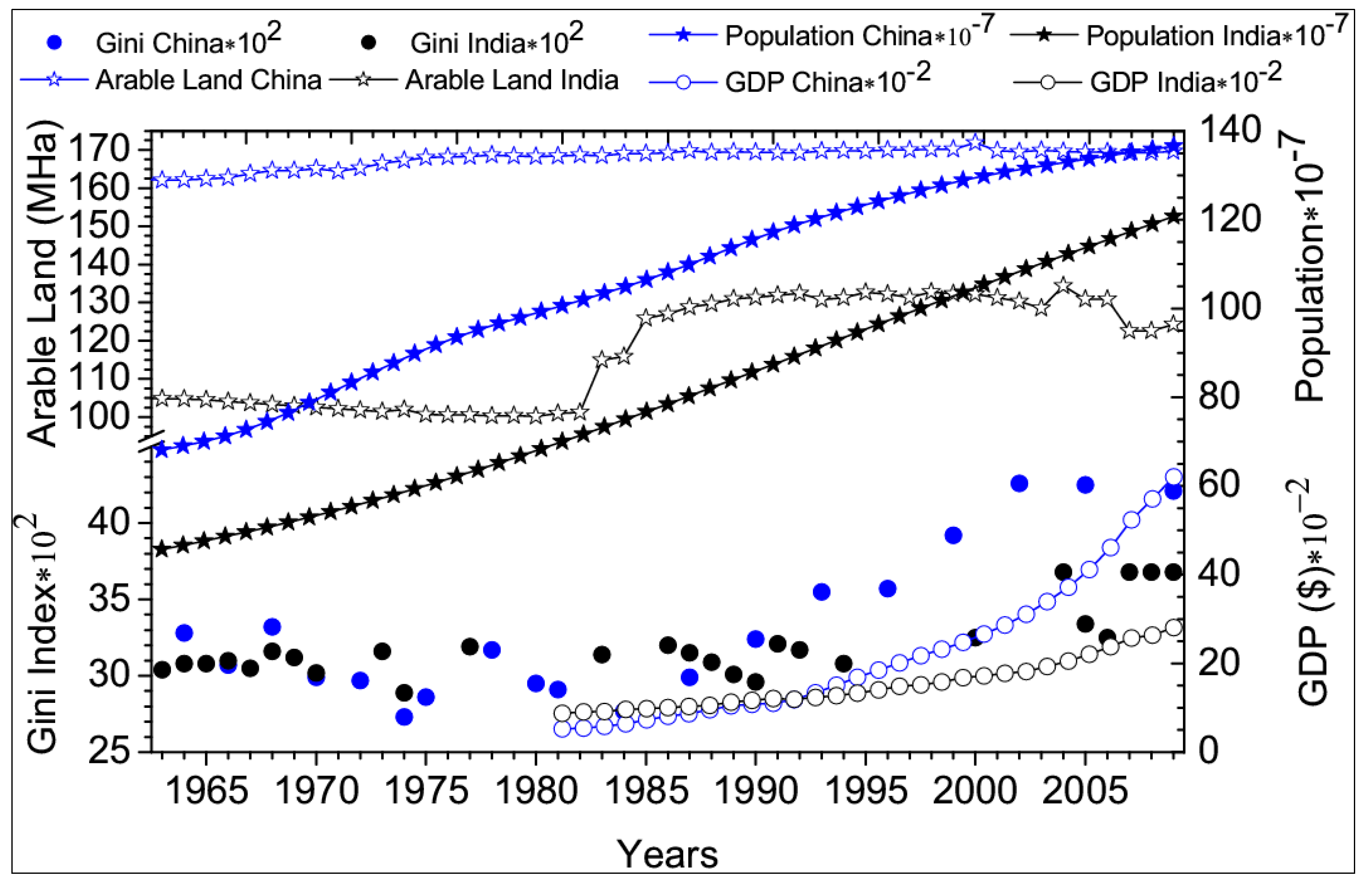
2. Study Area: India and China
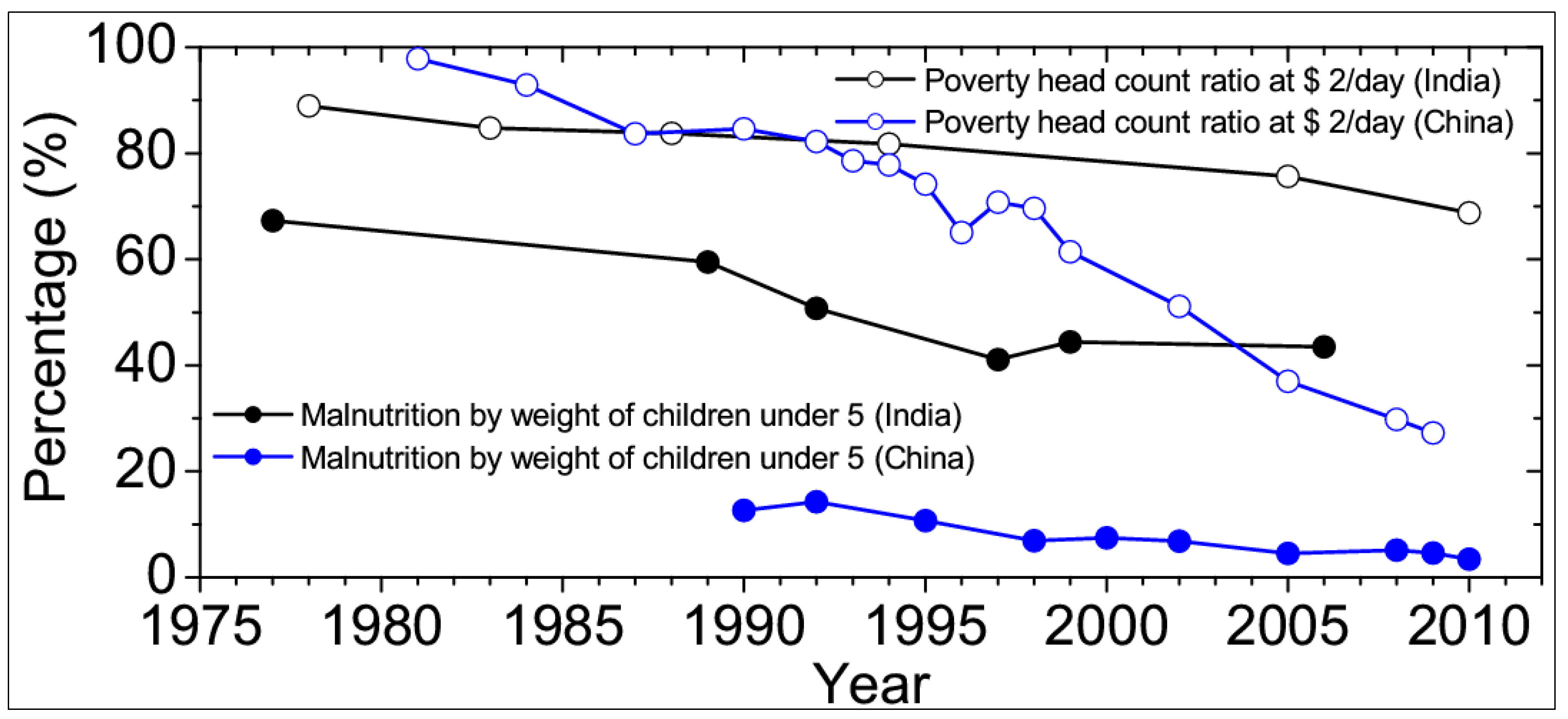
3. Data and Methodology
4. Results and Discussions
4.1. Consumption, Production, Diet Pattern and Per Capita Income Changes in Transition Economy
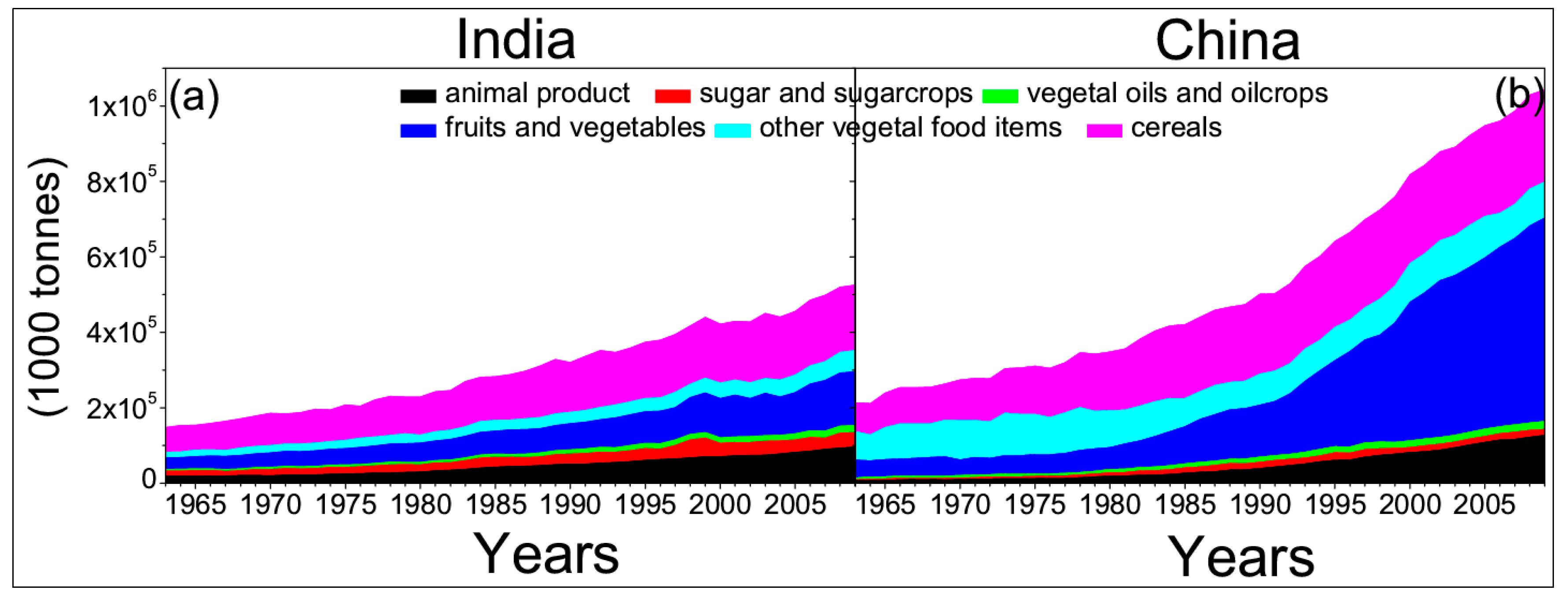

4.1.1. Consumption
4.1.2. Per Capita Consumption
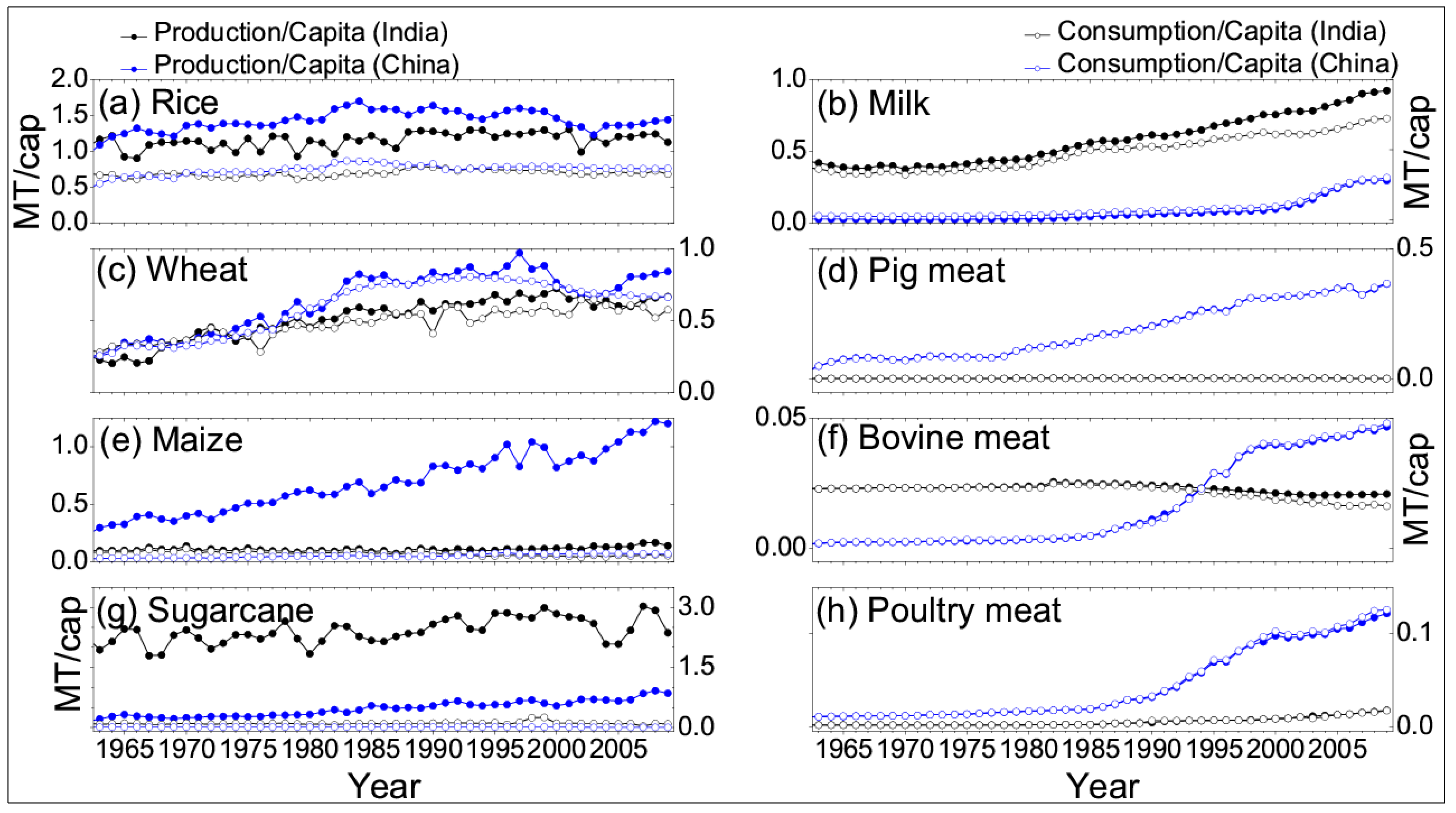
4.1.3. Per Capita Income
4.1.4. Per Capita Production and Consumption of Individual Food Items
4.2. Total and Per Capita Land Requirement for Food in India and China
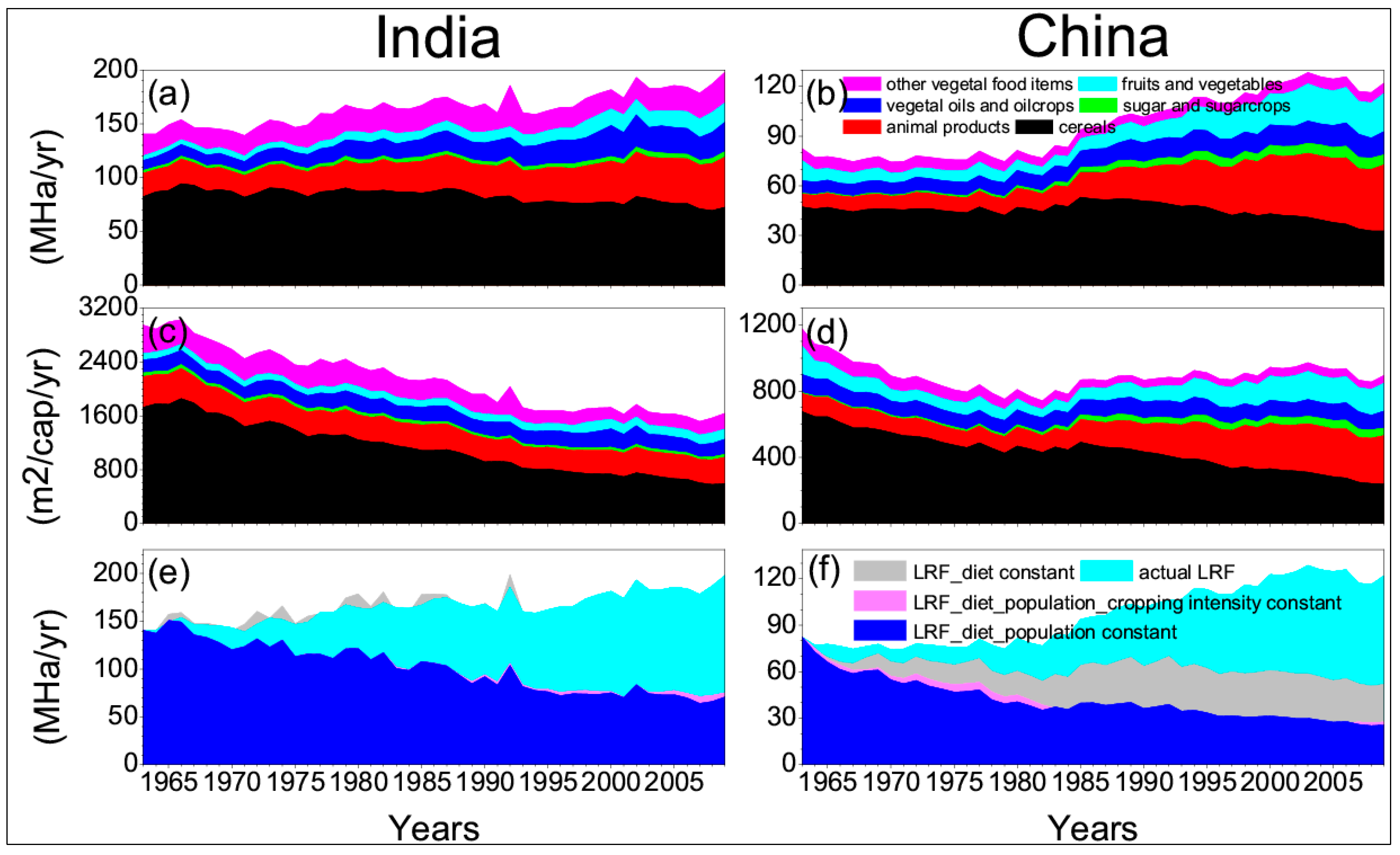
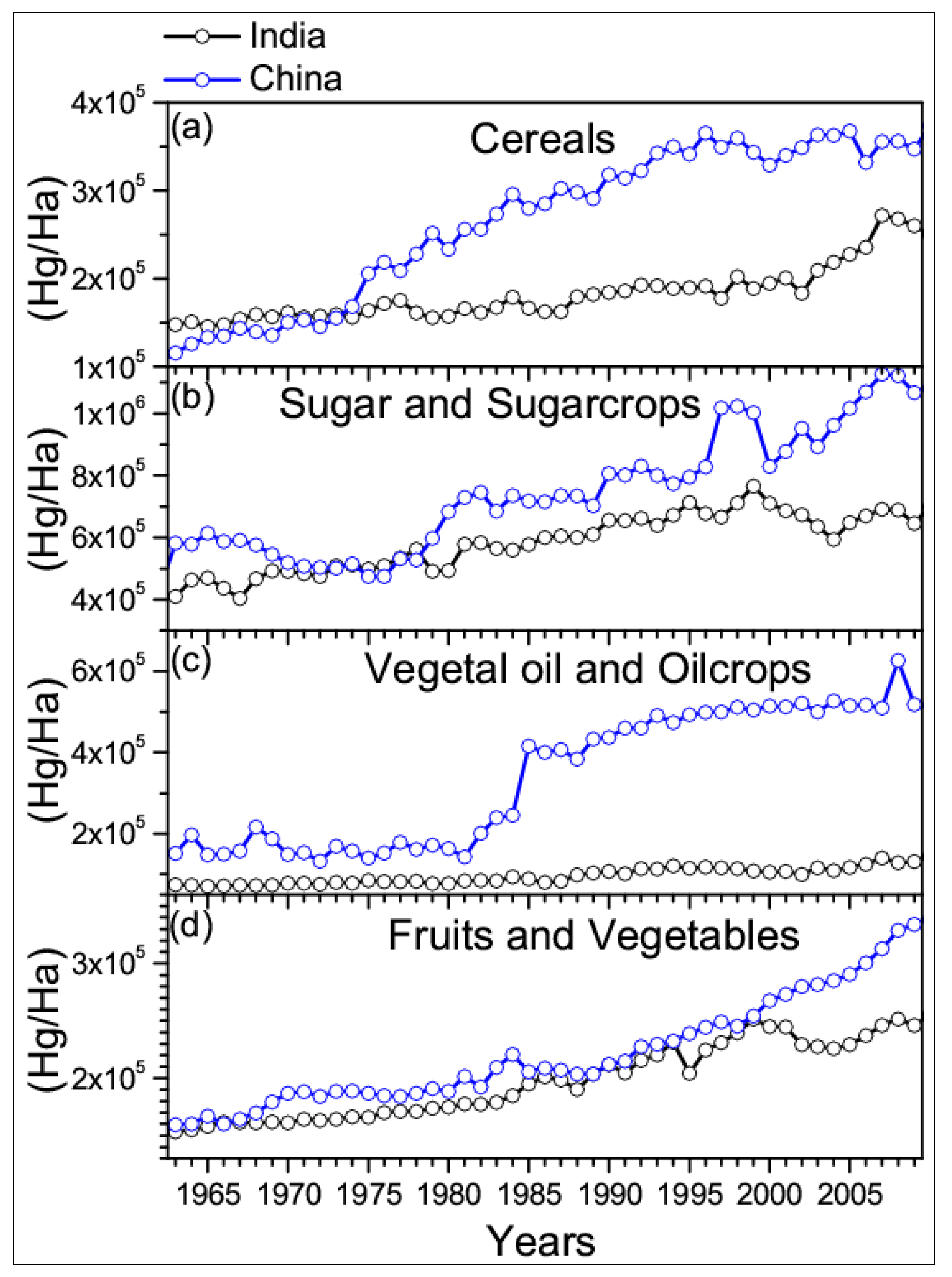
4.3. Individual Impact of Yield, Population, Cropping Intensity and Diet on LRF
5. India and China: Achievements, Challenges, Future Scenario and Role in Global Food Security
5.1. Government Policy and Food Security in India and China
5.1.1. China
5.1.2. India
5.2. Why the Role of India and China is Important for Future Global Food Security
5.3. Future Prospects of Growth and Challenges in Domestic Land Reform Policies
5.3.1. Shortage of Arable Land and Reform Policies
5.3.2. Environmental Degradation and Extreme Weather Events
5.4. Approach Towards Sustainable Agriculture

6. Conclusions and Discussions
Acknowledgments
Author Contributions
Supplementary Materials
Conflicts of Interest
References
- Population Reference Bureau. World Population Data Sheet; PRB: Washington, DC, USA, 2012. [Google Scholar]
- Ministry of Home Affairs. Census of India. In Rural Urban Distribution of Population Report; Ministry of Home Affairs: New Delhi, India, 2011. [Google Scholar]
- National Bureau of Statistics (NBS). Statistical Communique of the People’s Republic of China on the 2013 National Economic and Social Development; NBS: Beijing, China, 2014. [Google Scholar]
- Chaoui, L.M.; Leman, E.; Rufei, Z. Urban Trends and Policy in China. In OECD Regional Development Working Report; OECD: Paris, France, 2009. [Google Scholar]
- Guo, X.; Mroz, T.A.; Popkin, B.M.; Zhai, F. Structural change in the impact of income on food consumption in China, 1989–1993. Econ. Dev. Cult. Change 2000, 48, 737–760. [Google Scholar] [CrossRef]
- Popkin, B.M.; Paeratakul, S.; Zhai, F.; Ge, K. Dietary and environmental correlates of obesity in a population study in China. Obes. Res. 1995, 3, 135s–143s. [Google Scholar] [CrossRef] [PubMed]
- Van Ginkel, H. Urban Future. Nature 2008, 456, 32–33. [Google Scholar] [CrossRef] [PubMed]
- Delgado, C. Rising consumption of meat and milk in developing countries has created a new food revolution. J. Nutr. 2003, 133, 3907S–3910S. [Google Scholar] [PubMed]
- Jones, E.; Akbay, C.; Roe, B.; Chern, W.S. Analyses of consumers’ dietary behavior: An application of the AIDS model to supermarket scanner data. Agribusiness 2003, 19, 203–221. [Google Scholar] [CrossRef]
- Ishida, A.; Law, S.; Aita, Y. Changes in food consumption expenditure in Malaysia. Agribusiness 2003, 19, 61–76. [Google Scholar] [CrossRef]
- Liu, H.; Parton, K.; Zhou, Z.; Cox, R. At-home meat consumption in China: An empirical study. Austr. J. Agricult. Resour. Econ. 2009, 53, 485–501. [Google Scholar] [CrossRef]
- Gandhi, V.; Zhou, Z. Rising demand for livestock products in India: Nature, patterns and implications. Austr. Agribus. Rev. 2010, 18, 103–135. [Google Scholar]
- Ghosh, J. Poverty Reduction in China and India: Policy Implication of Recent Trends. Available online: http://www.un.org/esa/desa/papers/2010/wp92_2010.pdf (accessed on 28 April 2015).
- Rozelle, S.; Park, A.; Huang, J.K.; Jin, H. Liberalization and rural market integration in China. Am. J. Agric. Econ. 1997, 79, 635–642. [Google Scholar] [CrossRef]
- Zhou, Z.; Tian, W.M.; Liu, X.A.; Wan, G.H. Studying China’s Feed Grain Demand and Supply: Research Methodological Issues; Grains Research and Development Corporation: Canberra Australia, 2003. [Google Scholar]
- Huang, J.; Rozelle, S. China’s Agriculture: Drivers of Changes and Implications to China and the Rest of World. In Proceedings of the 27th International Association of Agricultural Economics Conference, Beijing, China, 16–22 August 2009.
- Baldwin, K.; Bonarriva, J. Feeding the Dragon and the Elephant How agricultural policies and trading regimes influence consumption in China and India. J. Int. Commer. Econ. 2013, 5, 1–16. [Google Scholar]
- Lin, J.Y. Rural reforms and agricultural growth in China. Am. Econ. Rev. 1992, 82, 34–51. [Google Scholar]
- Fan, S.; Kang, C.C. Road Development, Economic Growth and Poverty Reduction in China; Research Report 138; International Food Policy Research Institute: Washington DC, USA, 2005. [Google Scholar]
- FAOSTAT Database. India Country Profile. Available online: http://faostat.fao.org (accessed on 1 August 2012).
- FAOSTAT Database. China Country Profile. Available online: http://faostat.fao.org (accessed on 1 August 2012).
- FAOSTAT. Value of Agricultural Production; FAO: Rome, Italy, 2012. [Google Scholar]
- Quan, H. Income Inequality in China and India: Structural Comparisons; Asian Scholarship Foundation: Bangkok, Thailand, 2006. [Google Scholar]
- Zhang, X.; Mount, T.; Boisvert, R. Industrialization, Urbanization, and Land Use in China; International Food Policy Research Institute: Washington, DC, USA, 2000. [Google Scholar]
- Zhen, L.; Cao, S.; Cheng, S.; Xie, G.; Wei, Y.; Liu, X.; Li, F. Arable land requirements based on food consumption patterns: Case study in rural Guyuan District, Western China. Ecol. Econ. 2010, 69, 1443–1453. [Google Scholar] [CrossRef]
- Cai, Y.L.; Fu, Z.Q.; Dai, E.F. The minimum area for per capita of arable land and its implication for the optimization of land resource allocation. Acta Geogr. Sin. 2002, 57, 127–134. (In Chinese) [Google Scholar]
- Yang, W.; Yibo, L.; Chen, Y.; Xuefeng, C. Changes in the Land Requirements for Food from 1961 to 2007 in China. Resour. Sci. 2013, 35, 2. [Google Scholar]
- Yitzhaki, S. Relative Deprivation and the Gini Coefficient. Q. J. Econ. 1979, 93, 321–324. [Google Scholar] [CrossRef]
- Sadras, V.; Bongiovanni, R. Use of Lorenz curves and Gini coefficients to assess yield inequality within paddocks. Field Crops Res. 2004, 90, 303–310. [Google Scholar] [CrossRef]
- Mahal, A.; Karan, A.K. Adequacy of dietary intakes and poverty in India: Trends in the 1990s. Econ. Hum. Biol. 2008, 6, 57–74. [Google Scholar] [CrossRef] [PubMed]
- Svedberg, P. Child Malnutrition in India and China. 2020 Focus Brief on the World’s Poor and Hungry People; IFPRI: Washington, DC, USA, 2007. [Google Scholar]
- Kastner, T.; Nonhebel, S. Changes in land requirements for food in the Philippines: A historical analysis. Land Use Policy 2010, 27, 853–863. [Google Scholar] [CrossRef]
- FAO Food Balance Sheet-A HandBook. Available online: ftp://ftp.fao.org/docrep/fao/011/x9892e/x9892e00.pdf (accessed on 28 April 2015).
- Pradhan, P.; Ludeke, M.K.B.; Reusser, D.E.; Kropp, J.P. Embodied crop calories in animal products. Environ. Res. Lett. 2013. [Google Scholar] [CrossRef]
- Caballero, B.; Popkin, B.M. (Eds.) The Nutrition Transition Diet and Disease in the Developing World; Academic Press: London, UK, 2002.
- Albala, C.; Vio, F.; Kain, J.; Uauy, R. Nutrition transition in Chile determinants and consequences. Public Health Nutr. 2002, 5, 123–128. [Google Scholar] [CrossRef] [PubMed]
- Nath, R.; Cui, X.; Luan, Y.; Yang, W.; Li, Q.; Chen, W. Historical changes in land requirements for food in India. Indian J. Appl. Res. 2014, 4, 11–12. [Google Scholar]
- Barone, B.; Bin, P.; Brasili, C. Regional Disparity of Vulnerability to Food Insecurity in China. In Proceedings of the 3rd AIEAA Conference―Feeding the Planet and Greening Agriculture: Challenges and Opportunities for the Bio-Economy, Alghero, Italy, 25–27 June 2014.
- Mittal, S. What affect changes in cereal consumption? Econ. Polit. Wkly. 2007, 42, 444–447. [Google Scholar]
- Hubacek, K.; Guan, D.; Basu, A. Changing lifestyles and consumption patterns in developing countries: A scenario analysis for China and India. Futures 2007, 39, 1084–1096. [Google Scholar] [CrossRef]
- Zhou, Z.; Tian, W.; Wang, J.; Liu, H.; Cao, L. Food consumption Trends in China. Available online: http://www.agriculture.gov.au/SiteCollectionDocuments/agriculture-food/food/publications/food-consumption-trends-in-china/food-consumption-trends-in-china-v2.pdf (accessed on 28 April 2015).
- World Bank. “World Development Indicators” Database. Available online: http://data.worldbank.org/data-catalog/world-development-indicators (accessed on 28 April 2015).
- Faostat Food and Agriculture Organization of the United Nations. FAO Statistical Yearbook 2012; FAO: Rome, Italy, 2012. [Google Scholar]
- Liu, J.; Savenije, H.H.G. Food consumption patterns and their effect on water requirement in China. Hydrol. Earth Syst. Sci. 2008, 12, 887–898. [Google Scholar] [CrossRef]
- Fu, W.; Gandhi, V.P.; Cao, L.; Liu, H.; Zhou, Z. Rising consumption of animal products in china and india. National and global implications. China World Econ. 2012, 20, 88–106. [Google Scholar] [CrossRef]
- Mittal, S. Structural Shift in Demand for Food: India’s Prospects in 2020; Working Paper 184; Indian Council for Research on International Economic Relations (ICRIER): New Delhi, India, 2006; pp. 1–35. [Google Scholar]
- FAOSTAT Database. Food Balance Sheets; FAO: Rome, Italy, 2012. [Google Scholar]
- USDA FAS. PSD Database. Available online: https://apps.fas.usda.gov/psdonline/ (accessed on 29 April 2015).
- Siebert, S.; Portmann, F. T.; Doll, P. Global Patterns of Cropland Use Intensity. Remote Sens. 2010, 2, 1625–1643. [Google Scholar] [CrossRef]
- Department of Agriculture and Cooperation. India Report; Ministry of Agriculture: New Delhi, India, 2015. [Google Scholar]
- Frolking, S.; Qiu, J.; Boles, S.; Xiao, X.; Liu, J.; Zhuang, Y.; Li, C.; Qin, X. Combining remote sensing and ground census data to develop new maps of the distribution of rice agriculture in China. Glob. Biogeochem. Cycles 2002. [Google Scholar] [CrossRef]
- Qiu, J.J.; Tang, H.J.; Frolking, S.; Boles, S.; Li, C.; Xiao, X.; Liu, J.Y.; Zhuang, Y.H.; Qin, X.G. Mapping Single–Double- and triple-crop agriculture in China 0.5° × 0.5° by combining country scale census data with a remote sensing derived land cover map. Geocarto Int. 2003, 18, 3–13. [Google Scholar]
- Huimin, Y.; Xiangming, X.; Heqing, H.; Jiyuan, L.; Chen, J.; Xuedong, B. Multiple cropping intensity in China derived from agro meteorological observations and MODIS data. Chin. Geogr. Sci. 2014, 24, 1–14. [Google Scholar] [CrossRef]
- United States International Trade Commission. China’s Agricultural Trade. http://www.usitc.gov/publications/332/pub4219.pdf (accessed on 29 April 2015).
- Gbetibouo, G.A.; Hassan, R.M. Measuring the economic impact of climate change on major South African field crops: A Ricardian approach. Glob. Planet. Change 2005, 47, 143–152. [Google Scholar] [CrossRef]
- United States International Trade Commission. India: Effects of Tariffs and Nontariff Measures on U.S. Agricultural Exports. Available online: http://www.usitc.gov/publications/industry_econ_analysis_332/2009/india_effects_tariffs_and_nontariff_measures_us.htm (accessed on 29 April 2015).
- Benhin, J.K.A. South African crop farming and climate change: An economic assessment of impacts. Glob. Environ. Change-Hum. Policy Dimens. 2008, 18, 666–678. [Google Scholar] [CrossRef]
- Mooley, D.A.; Parthasarathy, B. Large scale drought over India and their impact on agricultural production. Mausam 1984, 35. Article 265. [Google Scholar]
- Walker, N.J.; Schulze, R.E. Climate change impacts on agro-ecosystem sustainability across three climate regions in the maize belt of South Africa. Agric. Ecosyst. Environ. 2008, 124, 114–124. [Google Scholar] [CrossRef]
- Blignaut, J.; Ueckermann, L.; Aronson, J. Agriculture production's sensitivity to changes in climate in South Africa. S. Afr. J. Sci. 2009, 105, 61–68. [Google Scholar] [CrossRef]
- Fan, S.; Brzeska, J. The role of emerging countries in global food security. IFPRI Policy Brief 2010, 15, 1–4. [Google Scholar]
- Food Scarcity-Trends, Challenges, Solutions. In Sustainability Team Discussion Paper; Candriam: New York, NY, USA, 2010.
- FAO. World Agriculture towards 2015/2030. In Summary Report; FAO: Rome, Italy, 2002. [Google Scholar]
- Rapid growth of selected Asian economies. In Synthesis Report, Policy Assistance Series 1/1; FAO Regional office for Asia and Pacific: Bangkok, Thailand, 2006.
- Li, C. Hu Jintao’s land Reform: Ambition, Ambiguity, and Anxiety. China Leadership Monitor 2008, 27, 1–22. [Google Scholar]
- Hansen, J.; Tuan, F.; Somwaru, A.; Seelay, R. Impact of China’s Agricultural Policies on Domestic and World Commodity Markets. In Proceedings of the International Association of Agricultural Economics Conference, Beijing, China, 16–22 August 2009.
- Global Water Partnership. Water and food security-Experiences in India and China. Available online: http://www.gwp.org/Global/ToolBox/Publications/Technical%20Focus%20Papers/03%20Water%20and%20Food%20Security%20-%20Experiences%20in%20India%20and%20China%20%282013%29.pdf (accessed on 29 April 2015).
- Kumar, P.; Mittal, S. Agricultural Productivity Trends in India: Sustainability Issues. Agric. Econ. Res. Rev. 2006, 19, 71–88. [Google Scholar]
- Fujita, K. The green revolution and its significance for economic development. In JICA-RI. Working Paper; JICA Research Institute: Tokyo, Japan, 2010. [Google Scholar]
- Upadhyay, R.P.; Palanivel, C. Challenges in achieving food security in India. Iran. J. Public Health 2011, 40, 31–36. [Google Scholar] [PubMed]
- Global Trade Information Services (GTIS). Global Trade Atlas Database. Available online: http://www.gtis.com/english/GTIS_GTA.html (accessed on 29 April 2015).
- Narayanan, B.; Walmsley, T. Global Trade, Assistance, and Production: The GTAP 7 Data Base; Center for Global Trade Analysis & Purdue University: West Lafayette, IN, USA, 2008. [Google Scholar]
- Food Security: Challenges and Solutions. In The Proceedings of the Global Food Security Forum, Shanghai, China, 6 November 2012; Available online: http://www.nottingham.ac.uk/globalfoodsecurity/documents/gfsforumreport2012.pdf (accessed on 29 April 2015).
- Ghose, B. Food security and Food Self-sufficiency in China: From past to 2050. Food Energy Secur. 2014, 3, 86–95. [Google Scholar] [CrossRef]
- Jie, C. Rapid urbanization in China: A real challenge to soil protection and food security. CATENA 2007, 69, 1–15. [Google Scholar] [CrossRef]
- Ghose, B.; Sajeeb, S.; Kpoghomou, M.A.; Gao, H.; Jun, L.; Yin, D.; Ghosh, S. Self-sufficiency in rice and food security: A South Asian perspective. Agric. Food Secur. 2013, 3, 2–10. [Google Scholar]
- Zhiyuan, L.; Zongwei, M.; Kujip, T.J.V.D.; Yuan, Z.; Huang, L. A review of soil heavy metal pollution from mines in China: Pollution and health risk assessment. Sci. Total Environ. 2014, 468–469, 843–853. [Google Scholar]
- Chadha, G.K.; Sen, S.; Sharma, H.R. State of the Indian Farmer: A Millennium Study; Ministry of Agriculture, Government of India: New Delhi, India, 2004.
- Pretty, J. Social capital and the collective management of resources. Science 2003, 302, 1912–1915. [Google Scholar] [CrossRef] [PubMed]
- Hoda, A.; Gulati, A. India’s Agricultural Trade Policy and Sustainable Development Goals. Available online: http://www.ictsd.org/downloads/2013/09/indias-agricultural-trade-policy-and-sustainable-development-goals.pdf (accessed on 29 April 2015).
- DFID. The Impact of Climate Change on Pro-Poor Growth; DFID: London, UK, 2004. [Google Scholar]
- Li, W. Agro-Ecological Farming Systems in China. In Man and the Biosphere Series; UNESCO: Paris, France, 2001; Volume 26. [Google Scholar]
© 2015 by the authors; licensee MDPI, Basel, Switzerland. This article is an open access article distributed under the terms and conditions of the Creative Commons Attribution license (http://creativecommons.org/licenses/by/4.0/).
Share and Cite
Nath, R.; Luan, Y.; Yang, W.; Yang, C.; Chen, W.; Li, Q.; Cui, X. Changes in Arable Land Demand for Food in India and China: A Potential Threat to Food Security. Sustainability 2015, 7, 5371-5397. https://doi.org/10.3390/su7055371
Nath R, Luan Y, Yang W, Yang C, Chen W, Li Q, Cui X. Changes in Arable Land Demand for Food in India and China: A Potential Threat to Food Security. Sustainability. 2015; 7(5):5371-5397. https://doi.org/10.3390/su7055371
Chicago/Turabian StyleNath, Reshmita, Yibo Luan, Wangming Yang, Chen Yang, Wen Chen, Qian Li, and Xuefeng Cui. 2015. "Changes in Arable Land Demand for Food in India and China: A Potential Threat to Food Security" Sustainability 7, no. 5: 5371-5397. https://doi.org/10.3390/su7055371




